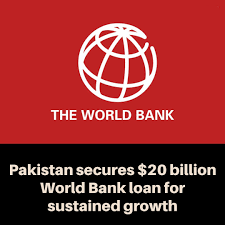The World Bank has announced a landmark $20 billion funding plan for Pakistan, spanning the next decade. This initiative, part of the Country Partnership Framework (CPF), aims to address critical socio-economic challenges while paving the way for sustainable development. With a focus on renewable energy, education, and healthcare, this plan signals a significant step forward in rebuilding Pakistan’s economic and social infrastructure.
The Objectives of the Funding Plan
The 10-year funding plan is built around three primary objectives:
- Supporting Economic Growth: By investing in infrastructure and industries, the plan aims to drive economic activity and generate employment.
- Promoting Sustainable Development: The emphasis on renewable energy and environmental sustainability ensures a greener future for Pakistan.
- Enhancing Social Welfare: Investments in education and healthcare are designed to uplift marginalized communities and reduce inequality.
Key Features of the 10-Year Plan
The $20 billion funding plan is structured around several key focus areas:
- Renewable Energy: A significant portion of the funds will be allocated to projects aimed at reducing reliance on fossil fuels.
- Education: Programs to improve literacy rates and skill development will receive dedicated attention.
- Healthcare: Investments in expanding healthcare infrastructure and services are prioritized.
This comprehensive approach reflects the World Bank’s commitment to addressing both immediate needs and long-term development goals.
Impact on Renewable Energy
Pakistan’s energy crisis has long hindered its economic progress. The funding plan aims to:
- Boost Green Energy Projects: Support for wind, solar, and hydropower projects will help diversify the energy mix.
- Reduce Dependence on Fossil Fuels: Transitioning to cleaner energy sources will lower carbon emissions.
- Encourage Innovation: Funding will be directed towards research and development of advanced energy technologies.
Investment in Education
Education remains a critical area for Pakistan’s growth. The funding will:
- Improve Access: Build schools in remote areas to ensure every child has access to quality education.
- Bridge the Urban-Rural Gap: Reduce disparities in educational resources and opportunities.
- Promote Skill Development: Vocational training programs will equip the youth with market-relevant skills.
Healthcare Improvements
Pakistan’s healthcare system has struggled to meet the needs of its growing population. With World Bank support:
- Infrastructure Expansion: New hospitals and clinics will be established in underserved regions.
- Maternal and Child Health: Initiatives to reduce maternal and infant mortality rates will be a priority.
- Disease Prevention: Programs focusing on vaccination and disease management will receive significant funding.
Economic Implications
The economic benefits of the funding plan are immense:
- Job Creation: Infrastructure and development projects will create millions of jobs.
- Encouraging Private Sector Participation: Collaboration with businesses will amplify the impact of public investments.
- Reducing Poverty: Increased economic activity will uplift low-income communities.
Challenges in Implementation
While the plan is ambitious, several challenges could hinder its success:
- Political Stability: Consistent policies are necessary for long-term projects.
- Efficient Fund Utilization: Ensuring the funds reach intended sectors is crucial.
- Transparency Issues: Monitoring mechanisms must be in place to prevent corruption.
Partnership with the Pakistani Government
The success of this plan hinges on a strong partnership between the World Bank and the Pakistani government. Collaborative planning and execution will ensure that the projects align with national priorities.
Global Perspective
Pakistan’s funding plan mirrors similar initiatives in developing nations. Lessons from other countries can help optimize the implementation process and maximize benefits.
Potential Risks
Several risks could undermine the plan’s effectiveness:
- Economic Mismanagement: Poor financial planning could derail progress.
- External Shocks: Global economic uncertainties might impact funding availability.
The Importance of Monitoring and Evaluation
To ensure success, robust monitoring mechanisms are essential. Regular evaluations and third-party audits will track progress and ensure accountability.
Public Reception and Expectations
The funding plan has been met with a mix of hope and skepticism. While many see it as a lifeline for Pakistan’s struggling economy, concerns about long-term debt persist.
Future Prospects for Pakistan
If implemented effectively, the 10-year funding plan could transform Pakistan. It offers an opportunity to build a resilient economy, improve living standards, and secure a sustainable future.
Conclusion
The World Bank 10 year funding plan is a bold and transformative initiative for Pakistan. By focusing on renewable energy, education, and healthcare, it aims to address systemic issues while fostering long-term growth. With effective implementation and collaboration, this plan has the potential to create a prosperous and sustainable future for the nation.
FAQs
- Why did the World Bank choose a 10-year timeframe?
The extended timeframe allows for sustainable and impactful development across multiple sectors. - How will the funding be distributed across sectors?
A significant portion will go to renewable energy, followed by education and healthcare initiatives. - What measures will ensure transparency?
Monitoring mechanisms, third-party audits, and government oversight will ensure accountability. - Will this funding increase Pakistan’s debt burden?
While the funding adds to external debt, its impact is offset by long-term economic growth and development. - How will ordinary citizens benefit?
Improved access to education, healthcare, and job opportunities will directly enhance the quality of life for millions.


